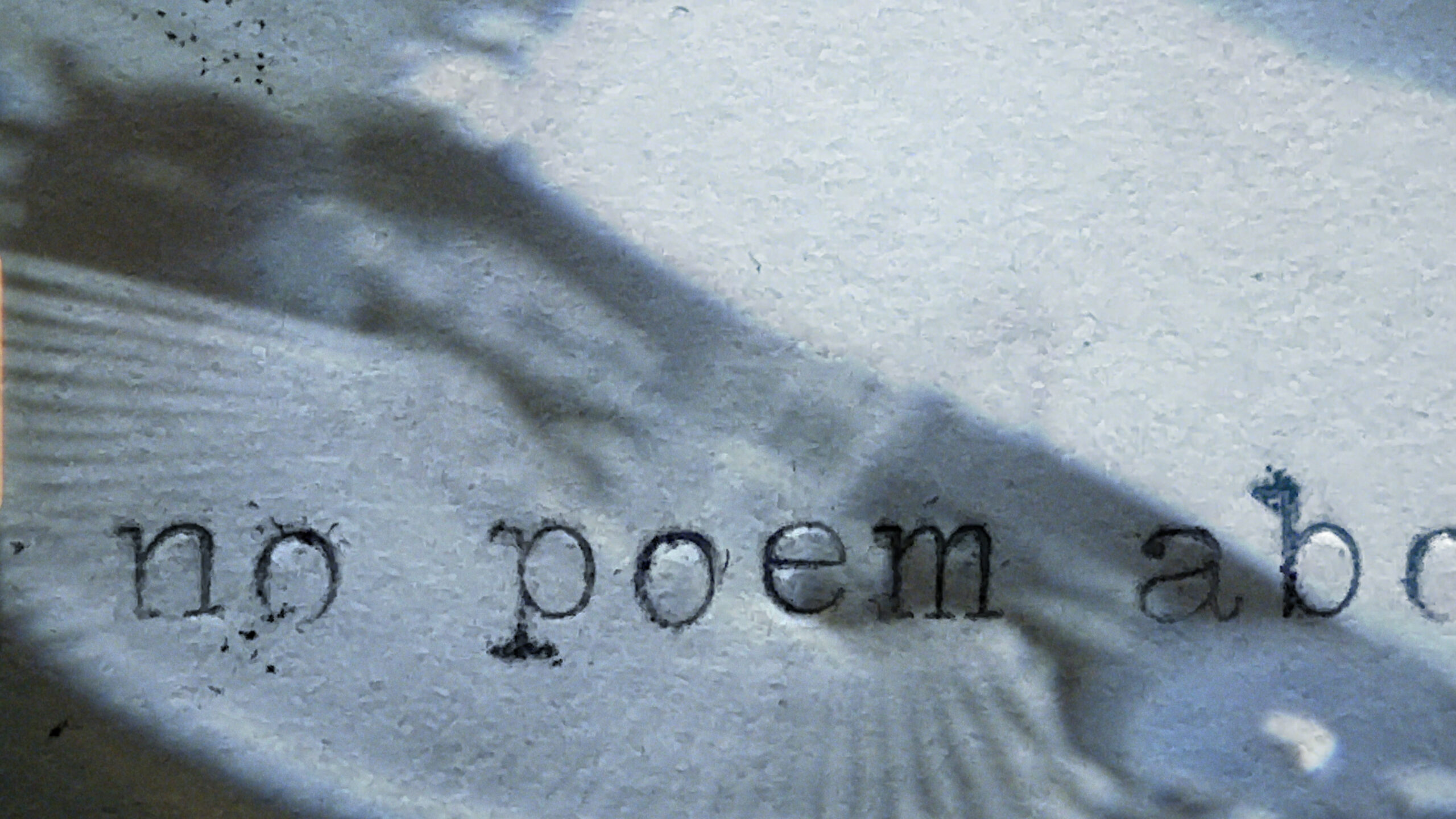
No Poem Animation
Elegiac as well as strangely hopeful, director Catherine Gund’s docu-poem, MEANWHILE, which premiered last year, has been one of the only things in recent memory that I have found soothing about the nature of humanity and the future of the world.
In close collaboration with Jacqueline Woodson (text), Meshell Ndegeocello (soundscape), Erika Dilday (support), and M Trevino (structure), Gund made a living – breathing – film that captures quiet, reflective moments from six artists in NYC as they continue with their lives and work throughout the many crises faced worldwide 2020-2021.
The themes evoked in MEANWHILE – survival, life, empathy, resilience, identity – feel even more relevant and urgent in 2025. By the time I saw the film this spring, the first planes of kidnapped immigrants had landed in El Salvador, a good friend at the Institute of Peace had called me to tearfully recount being physically removed from her workplace, and the United States seemed then as it does now to be marching with horrific determination toward authoritarianism.
Where do art and artists fit in during times of crisis? The conviction that art should or even can make meaning from and has potential to impact minor and major events, essentially that art matters – evident in the making of MEANWHILE – is as instinctual and vital as breath itself. “I believe there’s no way to survive without art,” Gund says, and what’s so moving in MEANWHILE is that without preaching or platitudes or predictions based in false hope or the end of the world, are messages about what art has to do with living and staying alive, and creates a humanistic portrait of how to face struggle with both softness and grit.
Interview by Rachel Dalamangas
The title MEANWHILE is evocative of time both on the scale of history as well as human life, and even the fleetingly momentary. The word is also suggestive of simultaneous action, and at various times throughout the film is associated with poetic themes of respite, freedom, and breath. When and over what period of time was this film shot? How did the word ‘meanwhile’ shape your approach to storytelling?
The title MEANWHILE was the beginning — it came before the film itself. That word held space for what we couldn’t yet articulate. We were living in a moment where the future had no language. In the face of the pandemic, the uprisings, the collapsing of systems that were never built for everyone, we were suspended in a kind of breath. MEANWHILE gave us a way to speak, poetically, politically. It holds multiplicity: the passing moment, the lifetime, the historic scale. It reminds us that while one story is unfolding, another is too — parallel lives, joys, violences, resistances, all breathing side by side. And never all joy or all violence.
If we’re always in a state of tension and chaos, and that energy is always moving, maybe the problem is that I’ve tried to stay still inside of it.
Is there a way to do things differently or to imagine
differently or practice living differently?
I don’t know that the natural condition of life is a state ofrelief.
Natalie Diaz
The film was shot over the course of 2020 and 2021 — those ruptured, reshaped years — but it wasn’t a linear shoot. It moved like breath, in and out, across time and tone. That rhythm shaped the structure: six verses, each a different facet of how we live, how we resist, how we care for each other. Some days were cinema verité, some days were poetry. Some moments were built on rage, others on care. We weren’t documenting a crisis — we were existing through it and creating from within it.
The word meanwhile grounded us. It reminded us that every image, every voice, is in conversation with something larger — with the past that made this present, and the future we’re still fighting to imagine. This isn’t escapism. It’s simultaneity — a way of being present to contradiction, to multiplicity, to all that breathes at once. Even in grief, there’s beauty. Even in stillness, there’s movement. MEANWHILE is a refusal to flatten the moment into one narrative. It’s a way to hold complexity — to breathe inside it.
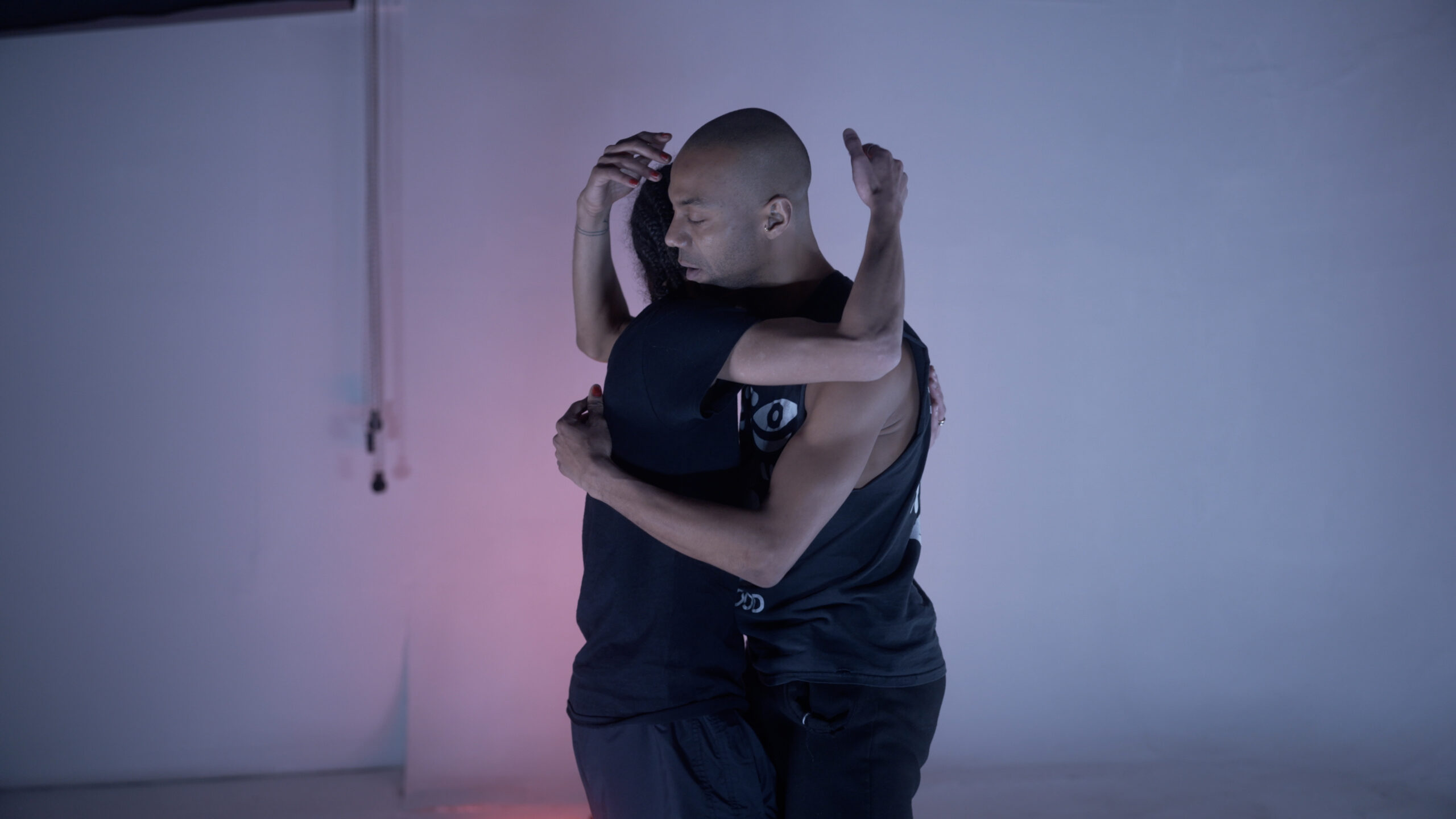
Shamel Pitts and Tushrik Fredericks
The film is formatted as a docu-poem in six parts. Did the author Jacqueline Woodson write the poem first and then the film was made, or was the film in progress and she responded to the footage?
Like the meanwhile, our film reveals synchronicity and simultaneity. We breathe to remember. We breathe to forget. The film began with Meshell Ndegeocello and me wanting to work together — to meld our associative, emotional, presence practices. Her sounds didn’t score the film; they scored the silence, the urge, the becoming. They created a space I could move inside. From those early pulses — breath and distortion, longing and loop — the film began to shape itself. Not in outline. In feeling. In time.
There was no sequence to our making. It wasn’t image, then music, then words. We were all inside the same storm. Meshell would send a sound, and I’d hold it up to the light of the footage. Jacqueline would listen, then speak a line:
“Like the newborn baby
who hasn’t yet heard the sound of her own cry,
we know, without the tears, that we’re alive.
We know long before we feel the pain of the outside world
that we are whole.
The fight already in our breath,
the fight in our hearts.”
Those words would ripple back to the edit, bend the image, slow the cut. We are born into interruption. Everything was responsive. We weren’t documenting — we were composing a present tense. Existing alongside.
The film unfolds in six verses. Not chapters. Not acts. Verses — because poetry was the only structure that could hold us, could breathe with us. Jacqueline didn’t write about the film; she wrote inside it. Her words were not commentary. They were blood and breath. Sometimes I would send her images pulled from her language. Other times, in the middle of this breath, this heartbeat, this fire, I would cut a scene just to leave space for a line to land:
“Even in the fire, we can’t extricate ourselves.
We’re all connected. Ancestors, aunts, uncles, children.
The blood that moves through our veins sings the same song —
a song we can pretend we don’t hear,
a song an inch away from our ears,
a song being sung always in the meanwhile.”
Everyone who appears in the film also creates from their own fire, their own heart, in an exchange that reverberates. We were finding a place where everyone’s path touches another — or doesn’t pass at all, but lingers nearby. In rehearsal, dancer Shamel Pitts says:
“There’s still this heat between us,
the sense of touch without touching,
and the heat that comes between this, from this —
and that we keep that alive.”
We weren’t illustrating a thesis. We were living a practice — of listening, of responding, of being changed by the work and each other. Nothing was finished until everything was. And even now, I don’t think of the film as complete. It’s still pulsing. Still saying:
“And we keep on keeping on
in all the ways, in always,
in all the spaces of time —
including in the meanwhile.
Meanwhile, we live.”
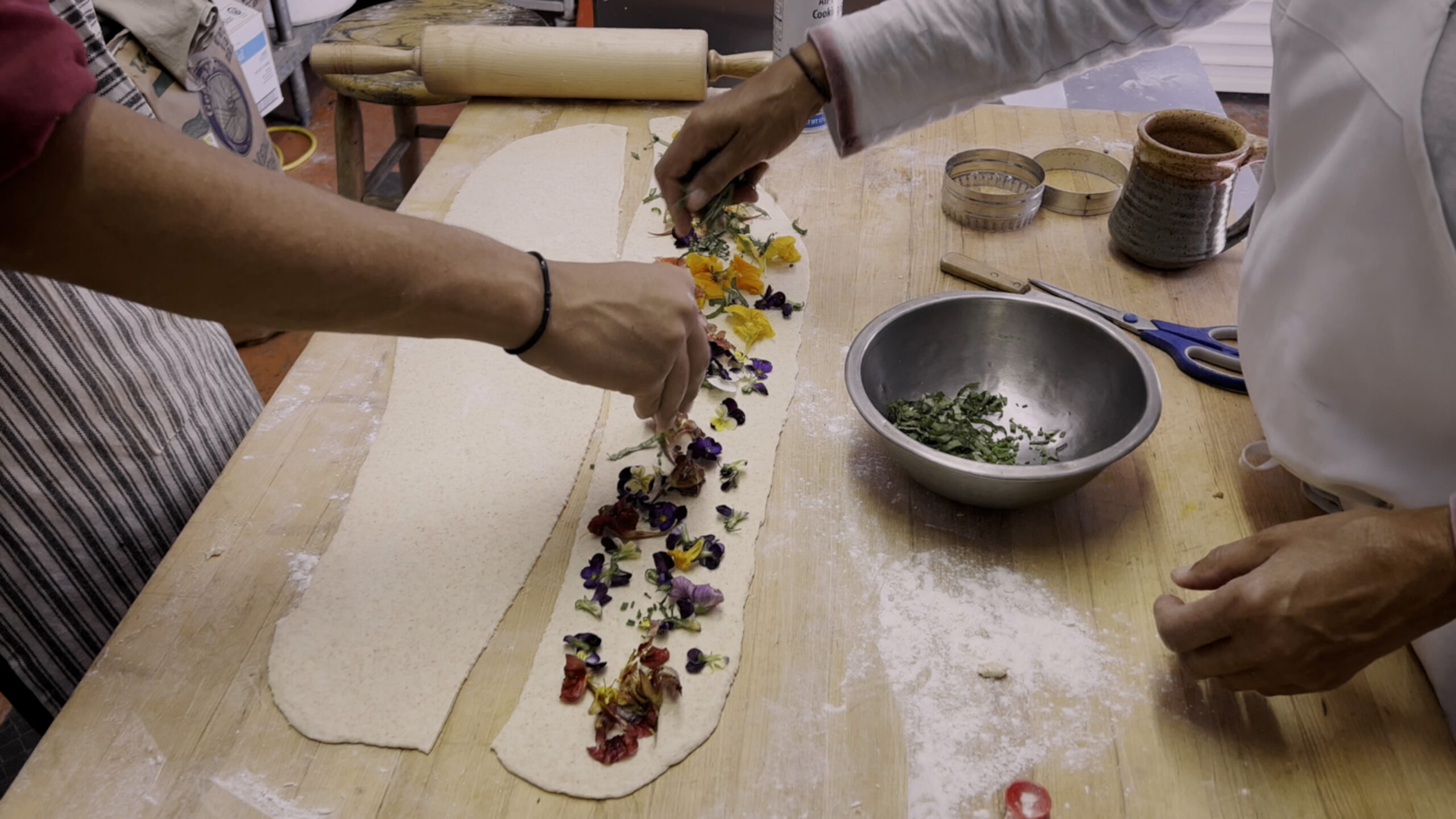
Juli Vanderhoop baking
The theme of breath is relevant both in the form of projective verse poetry as well as politically to the BLM movement, which adopted the last words of Eric Garner as slogan. Was this an intentional motif or one that arose organically through the process of making the film?
Breath was never a motif. It is the medium. Breathing is the pulse of the film, the rhythm that sustains and connects every frame.
This understanding didn’t begin as an intellectual choice — it emerged as a force, moving through us, through the footage, through the sound, through the words. Breath is political. It always has been. It’s the first act of life and the last. It’s the rhythm of survival — the breath that sustains, that resists, that says: I am still here, even in the face of forces that would seek to silence us.
In MEANWHILE, breath is the connective tissue — between image, sound, and word. It was the anchor of the time we were living in: the pandemic, where breathing became dangerous, measured, protected by machines; and the uprisings, where breath was denied. When Eric Garner said “I can’t breathe”, those words became a collective reckoning. We didn’t set out to make a film about breath, but breath insisted on being seen, heard, and felt. It rose up in Meshell’s looping, gasping, panting soundscapes; in Jacqueline’s verses, which returned, again and again, to one essential instruction: Breathe.
Breath is intimate. It’s ancestral. It’s violent. It’s liberating. We hear panting, inhaling, gasping, exhaling. We hear people breathing throughout the film. And the film breathes – expands and contracts, grips and releases – following the tension of our lives. Then quiet. This is the rhythm of the film’s structure – our fight to move through grief, through rage, through hope.
The film is about living in that tension. We breathe to remember. We breathe to forget. Breath is not just metaphor — it’s a condition of resistance and resilience. A refusal to be erased. A way of holding space for the past and the possible. It is the heartbeat of MEANWHILE, beating in rhythm with the ongoing fight for racial justice, for lasting freedom.
When Jacqueline says, “The fight already in our breath, the fight in our hearts,” she isn’t just talking about survival. She’s invoking the right to live fully, audaciously. To breathe freely and unapologetically is a radical act and I think of how breath moves invisibly, but always between us. How it connects us across time and struggle. How it carries memory. How it carries forward.
It’s the unspoken and shared, the invisible force that connects us across time, space, and struggle. It’s the space where our histories converge, where we hold each other in the weight of what we carry. Meanwhile, in the fire, in the heat, in the breath — we keep going.
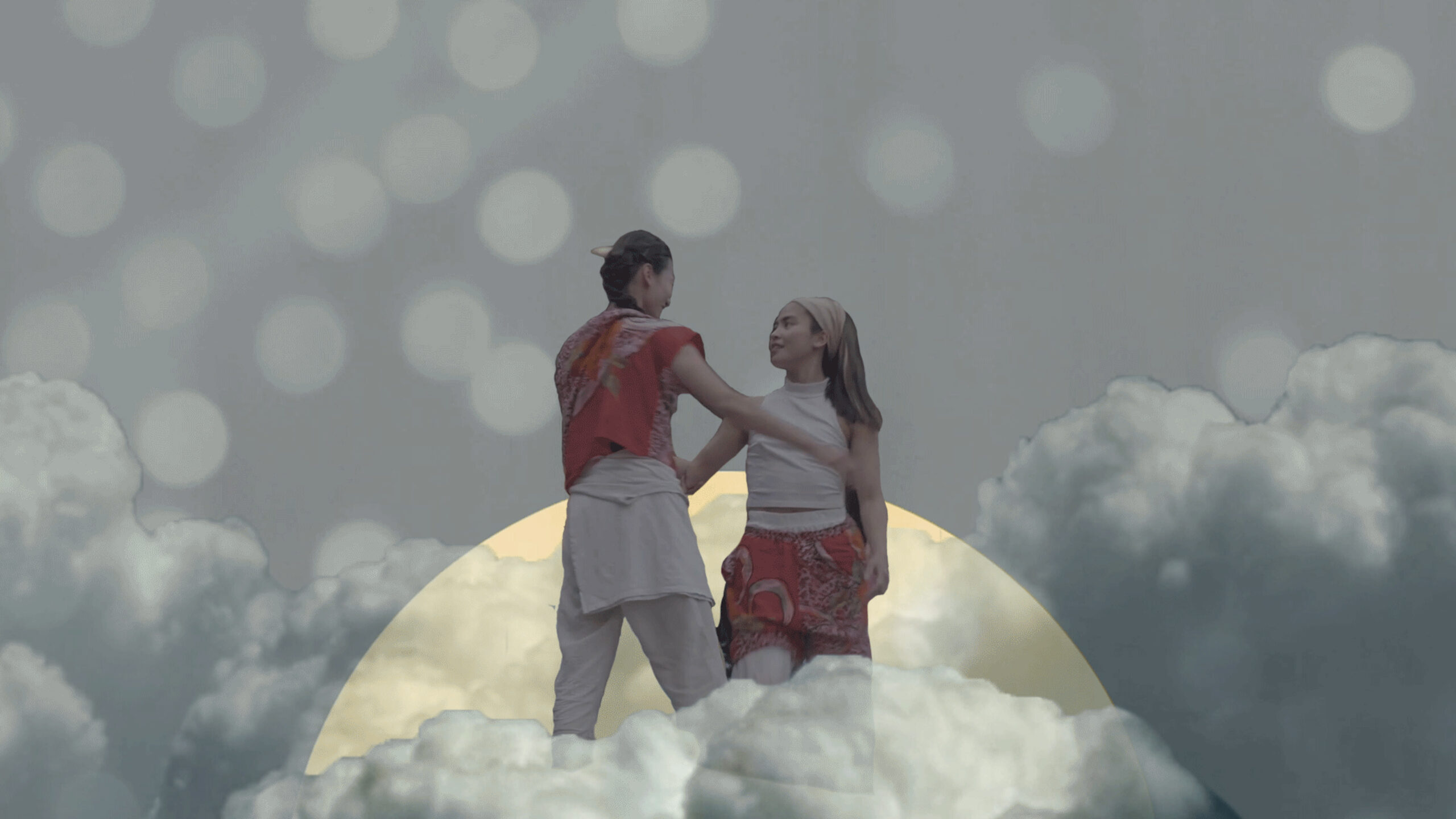
Fire Dancers Animation
Questions about identity begin with the individual, and move outward into race and its constructs, questions about masculinity and about who gets to be American, and through the interconnectedness of New Yorkers going about the quotidian and quiet labor of an artist’s work, a portrait of humanity emerges. What was your approach to capturing that spectrum when choosing participants and how did you think about balancing the political with the deeply personal?
Identity is not a static form, a fixed shape; it’s a dynamic condition we inhabit. It evolves, stretches, contradicts, and becomes through our interactions, our memories, our exposure, and our familiarity. It’s not something we craft from a distance. It works on us, over time, through relation. And the questions it raises — about belonging, about freedom, about who we are allowed to be — are not theoretical. They live in our bodies, in our practices, in how we move through the world.
MEANWHILE was made with people I love, people I’ve been in conversation with for years — sometimes decades. Meshell. Jacquelin. Daniel Alexander Jones. Juli Vanderhoop. Dana Davis.
The film didn’t begin by assembling a cast. It began in community.
It began in trust. These aren’t interviews. These are continuations — of friendships, of artistic dialogues, of shared wondering, shaped over time. The people in the film are artists, yes, but they’re also thinkers, caregivers, visionaries. They’re in the middle of making something — not just a piece of work, but a way of living, of imagining beyond what’s already here.
We filmed across many places — Ohio, California, Massachusetts, New York — and what emerged wasn’t a portrait of place, but a portrait of relation. Of people listening to one another. Showing up. Risking being seen. The political and the personal were never separate — they’re part of the same breath. They shaped each other.
“We’re not always legible to one another… this idea
that something’s sort of hiding in plain sight, or that we can see
one another in lots of different ways — or not see
one another. I’m really interested
in that idea of degrees of not seeing.”
Teresita Fernández
That idea — of degrees of seeing, of allowing space for what can’t be named yet — became central. The film invites a kind of seeing that is slower, more generous, more curious. A seeing that doesn’t close down with certainty, but opens toward connection.
MEANWHILE doesn’t claim to define identity. It holds it in motion. It asks: What can we be, together, when we listen beyond the obvious? When we allow each other to be in process? The film became a kind of shared language — not to simplify who we are, but to stretch what we think is possible.
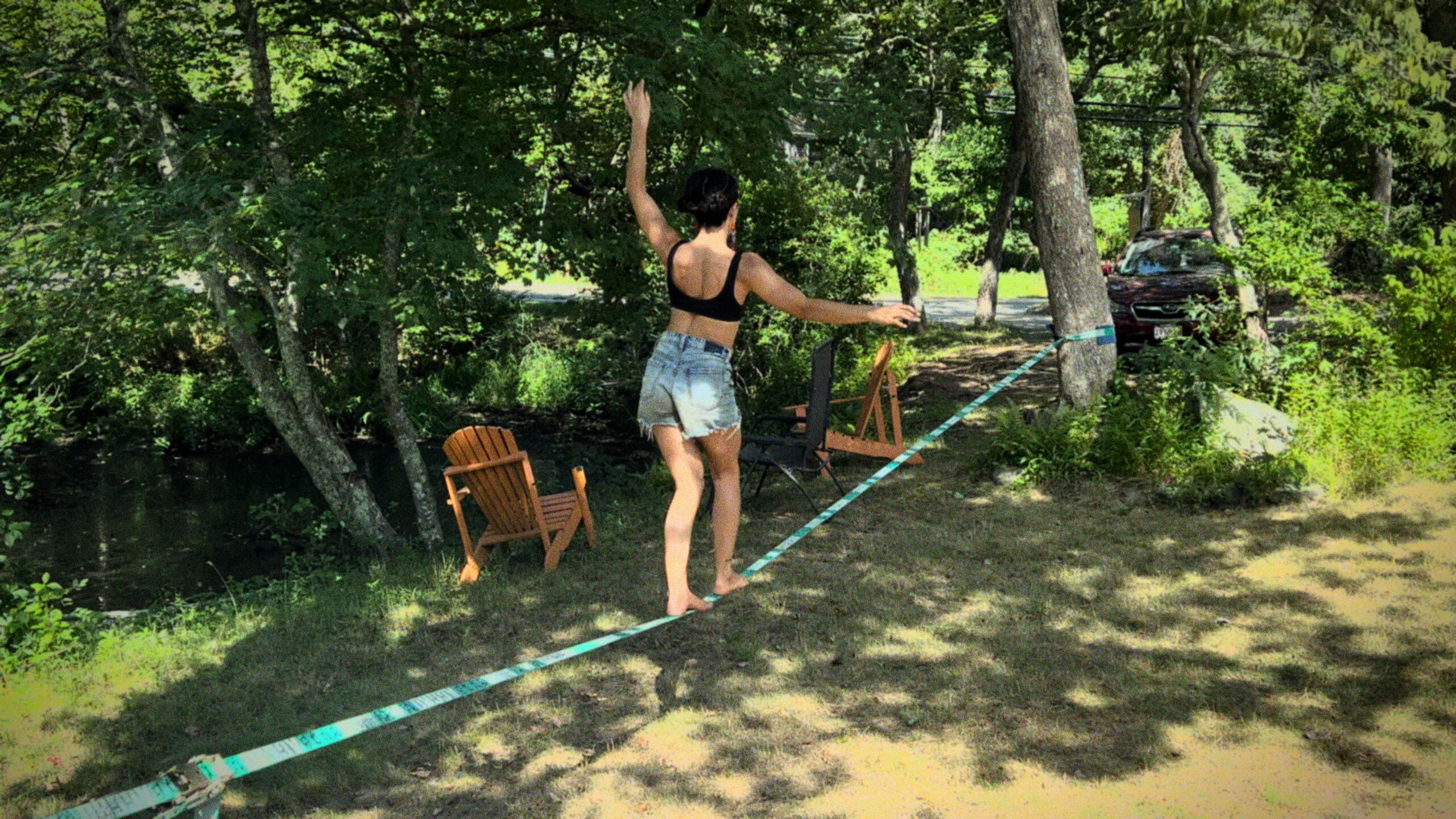
Artist, Ella Mahoney
In the first couple minutes of the film, a participant makes an appeal to empathy (“I see what you see”). It’s interesting because I believe that that is the reach that quite a bit of art makes – the gap between what I see and what you see. After making the film, what do you think art can do in the face of injustice, cruelty, and greed?
I believe there’s no way to survive without art. It shapes how we live inside the world, how we metabolize what it does to us. Art heals, it educates, it dignifies, it can be glorious despite the unbearable, it transforms us. It gives us somewhere to place the weight. The film doesn’t offer answers, it offers presence, a shared space where questions can breathe.
I think of that moment you mention — “I see what you see” — not as a claim to sameness, but a reaching across, through, towards. An opening. In MEANWHILE, that reach is what binds everything – between strangers, collaborators, neighbors, generations. Not agreement, but proximity. Not clarity, but care. That’s what art can do: make space for what doesn’t fit anywhere else or what has been systematically erased, sidelined, omitted. Hidden in plain sight. Art keeps watch. Art will make time for what has been refused. Make beauty without asking permission.
And in the meantime — in the meanwhile — art becomes a site of resistance. But also of tenderness. Of imagination. When the systems we live inside are built on extraction, on forgetting, on violence, art says: still, we breathe. Still, we make. Still, we sing and speak and move. Even here. Especially here.
Art doesn’t end injustice, but it refuses to normalize it. It offers a space
to metabolize, to feel, and to grieve
the violence more deeply. It keeps injustice from calcifying
into silence. It’s not decoration. It’s declaration. A refusal
to disappear. A way of holding on — to memory, to vision, to
each other.
In MEANWHILE, the act of making was a way to stay alive inside a brutal moment. Not to escape it, but to be fully awake to it — and still imagine. Still dream. Still build. Still create something big enough. Something tender, spacious, honest enough to carry us. I think of the dancers in rehearsal, the breathwork, the slowness of Jacqueline’s line landing, “Even in the fire, we can’t extricate ourselves… the blood that moves through our veins sings the same song…” That’s what art can do. It doesn’t look away. It sings in the fire.
I believe art is a space where grief doesn’t collapse
us. Where beauty isn’t naive. Where the imagined is as real
as the inherited. Where we can
say — we are still here. And we are still dreaming.
Rachel Dalamangas is the current managing editor of zingmagazine.
Image credits: Abramorama
May 5, 2025
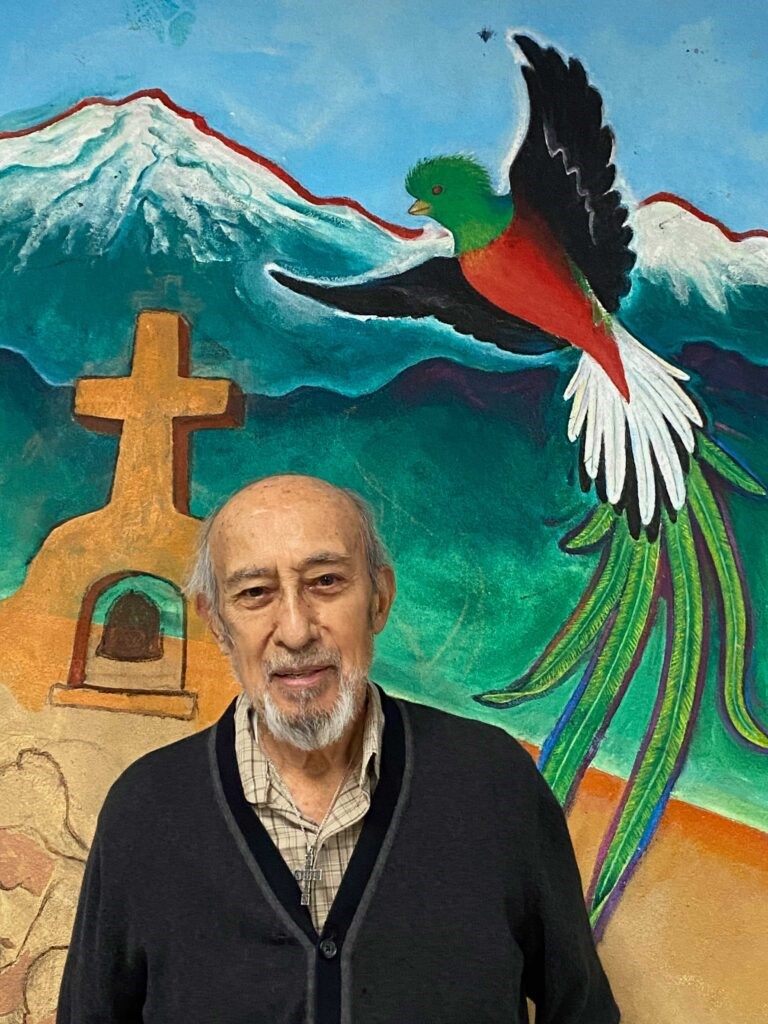
Although his work hasn’t thus appeared in a print edition of zing, Leo Tanguma has twice appeared in interviews for this blog – first in 2012 when I profiled him and years later when he was interviewed by scholars Ben Gillespie and Josh T Franco from the Smithsonian’s Archives of American Art.
Originally from Texas – and claiming that his first mural was a chalk drawing of the town’s corrupt sheriff who terrorized the Chicano community – Tanguma’s presence for over 40 years in Denver and contributions to contemporary art and public arts projects have been meaningful to establishing Chicano art and muralism as integral to American history and modern culture.
His murals, in the same legacy as Siqueiros, are often political, telling stories of overcoming oppression, violence, and greed. His public profile was raised later when two major works on permanent view at DIA: In Peace and Harmony with Nature and The Children of the World Dream of Peace caught the attention of online conspiracy theorists who were determined to prove DIA had an apocalypse bunker for the wealthy and powerful. (My own late father was the superintendent of labor for the West Terminal and said there’s a tornado shelter, but no luxury bunker).
When I took a bus out to the foothills and visited Tanguma for that first interview in 2012, I was struck by how sincere and eager he was to do good with art – that he fiercely believed it was art’s job to address hardship.
For Cinco de Mayo (especially if you’re in Denver), read about Tanguma in zing here and here.
-Rachel Dalamangas
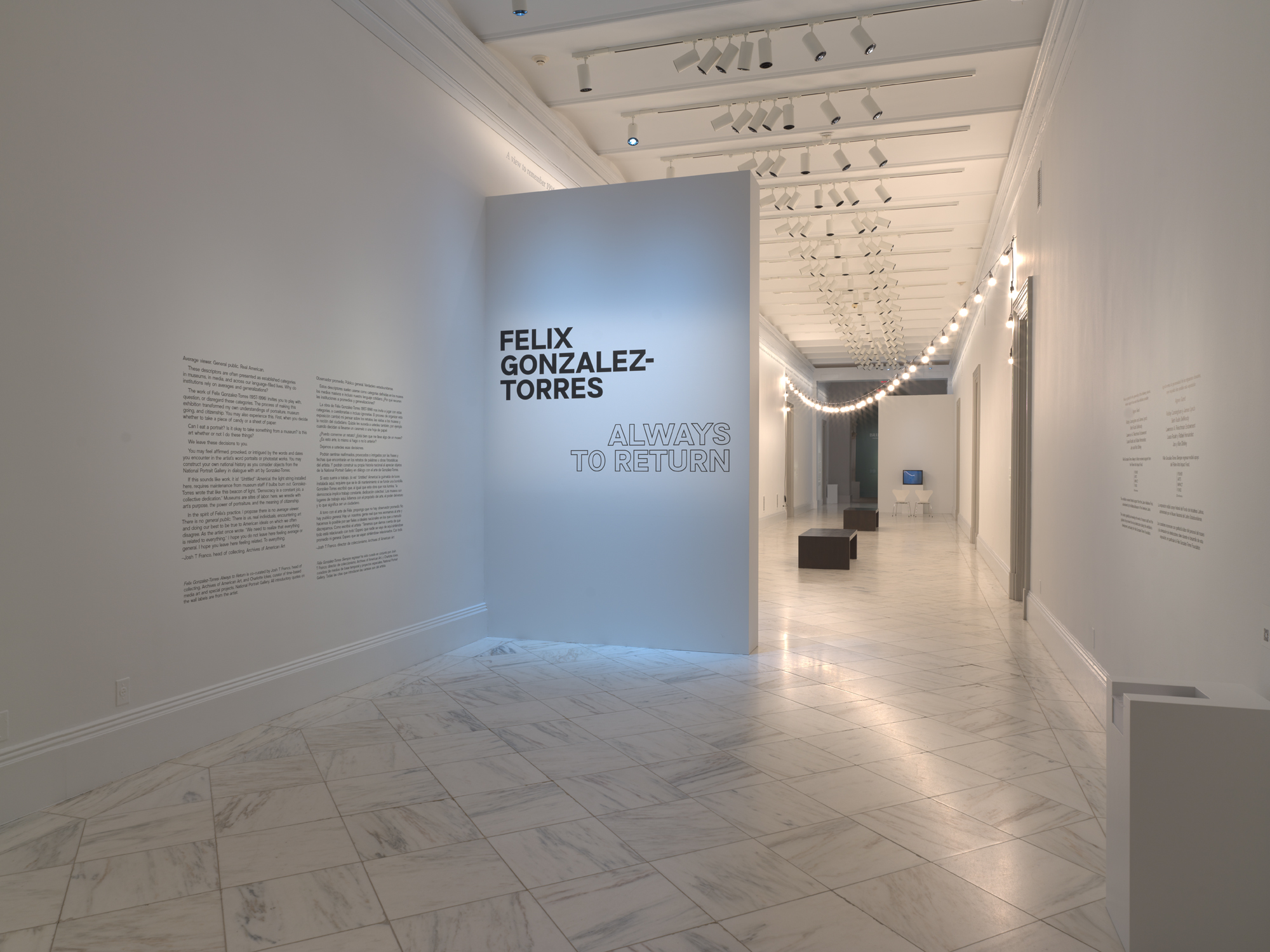
Installation view of Felix Gonzalez-Torres: Always to Return
(Photo by Mark Gulezian/National Portrait Gallery)
Art historian Charlotte Ickes is Curator of Time-Based Media Art and Special Projects at the National Portrait Gallery in Washington, D.C. Among her recent projects, she co-curated Isaac Julien: Lessons of the Hour—Frederick Douglass (2023–2026) and Viewfinder: Women’s Film and Video from the Smithsonian (2021). She also commissioned Birthright (2022), a performance by Maren Hassinger. Her latest exhibition, Felix Gonzalez-Torres: Always to Return, is co-curated with Josh T Franco, Collector at Large at the Archives of American Art.
Introduction and Interview by Claire Dillon
I love it when people say: ‘But it is just paper. It is just two clocks next to each other. It is just light bulbs hanging.’ I love the idea of being an infiltrator. I always said that I wanted to be a spy. I want my artwork to look like something else, non-artistic yet beautifully simple.
– Felix Gonzalez-Torres in conversation with Tim Rollins, 1993
The exhibition Felix Gonzalez-Torres: Always to Return begins outdoors, beyond the walls of the National Portrait Gallery and Archives of American Art. Visitors first encounter strings of lights from “Untitled” (America) (1994) hanging from the venue’s façade, lining 8th Street NW, and shining through the windows of the Martin Luther King Jr. Memorial Library next door. When I saw the exhibition in December 2024, “Untitled” (America) was also intertwined with a second set of lights, which decorated the local holiday market. As they subtly swayed in the crisp air, the warm glow of the artwork’s frosted bulbs contrasted with the clear lights installed for the season’s festivities.
A label accompanying this installation can be found indoors and through QR codes pasted to the sidewalk. The text in the library explains the key components of the work, and continues with an interpretation:
When illuminated, “Untitled” (America) requires continued maintenance from library staff who must replace burned bulbs. ‘Democracy is a constant job, a collective dedication,’ Gonzalez-Torres wrote in a statement about “Untitled” (America). As a beacon hovering between promise and precarity, this work, like democracy, requires choice, maintenance, vigilance, and labor. During election season, the DCPL [District of Columbia Public Library] serves as a voting site. Without voting representatives in Congress, D.C. residents are only partially enfranchised. Exhibited in this context, what meanings about democracy does this work generate? As the artist said he hoped the work ‘will light some peoples’ spaces, at least for a short time.’ Hopefully, “Untitled” (America) ‘lights your space’ as you read, eat, and attend civic programs at the library, the museum across the street, and elsewhere.
This brief description of the installation raises several themes that permeate the work and this exhibition: by using everyday objects to create untitled artworks, most of Gonzalez-Torres’s pieces remain open to infinite interpretation. While his parenthetical titles suggest directions for contemplation, the responses of the audience and curators are just as important as the artist’s intentions. In this case, the title of the work and its installation by a museum of portraiture prompt consideration of the conventions of representation, not only of people, but also of concepts like America.
Site-specific interpretation is a recurrent theme in this exhibition of Gonzalez-Torres’s art, and it is particularly significant because this is the first major presentation of his work in the nation’s capital in three decades. Collaborating between the National Portrait Gallery and Archives of American Art, Ickes and Franco staged original juxtapositions between the institutions’ permanent collections and Gonzalez-Torres’s work. In doing so, they interrogate the themes of portraiture, institutions, politics, and constructions of public, private, identity, and history. For example, the artist’s photographs of the American Museum of Natural History’s memorial to Theodore Roosevelt—documenting only the engraved words Historian, Scientist, Statesman, and Ranchman rather than the infamous equestrian statue—are displayed next to Roosevelt’s painted portrait in the Gallery’s permanent exhibition, America’s Presidents. Gonzalez-Torres’s nonrepresentational approach challenges expectations of what a portrait can be, and this exhibition created unique opportunities to compare his work with traditional definitions of this genre.
The extension of Gonzalez-Torres’s work into other exhibitions within the museum and into the city recalls an oft-quoted 1995 interview with Robert Storr, in which the artist stated:
There’s a great quote by the director of the Christian Coalition, who said that he wanted to be a spy. ‘I want to be invisible,’ he said, ‘I do guerilla warfare, I paint my face and travel at night. You don’t know until election night.’ This is good! This is brilliant! Here the Left we should stop wearing the fucked-up T-shirts that say ‘Vegetarian Now.’ No, go to a meeting and infiltrate and then once you are inside, try to have an effect. I want to be a spy, too. I do want to be the one who resembles something else. We should have been thinking about that long ago. We have to restructure our strategies and realize that the red banner with the red raised fist didn’t work in the sixties and it’s not going to work now. I don’t want to be the enemy anymore. The enemy is too easy to dismiss and to attack. The thing that I want to do sometimes with some of these pieces about homosexual desire is to be more inclusive. Every time they see a clock or a stack of paper or a curtain, I want them to think twice.
Today, his piles of candy and stacks of paper stand quietly, but powerfully, among works in the permanent collection. In my mind, the presence of Gonzalez-Torres’s work amidst both a holiday market and an exhibition of presidential portraits is a perfect demonstration of this strategy. In another example, pictured below, the artist’s paper stack “Untitled” (Death by Gun) (1990)—a record of 464 victims of gun violence in the first week of May 1989—sits beneath Christian Schussele’s painting Men of Progress (1862), which depicts American inventors, including firearms manufacturer Samuel Colt. The men are represented in a fictive meeting in the very building in which this exhibition is now held: the former U.S. Patent Office. This pairing attests to the artist’s ability to intervene in such institutions, and the curators’ careful consideration of the site in which they work.
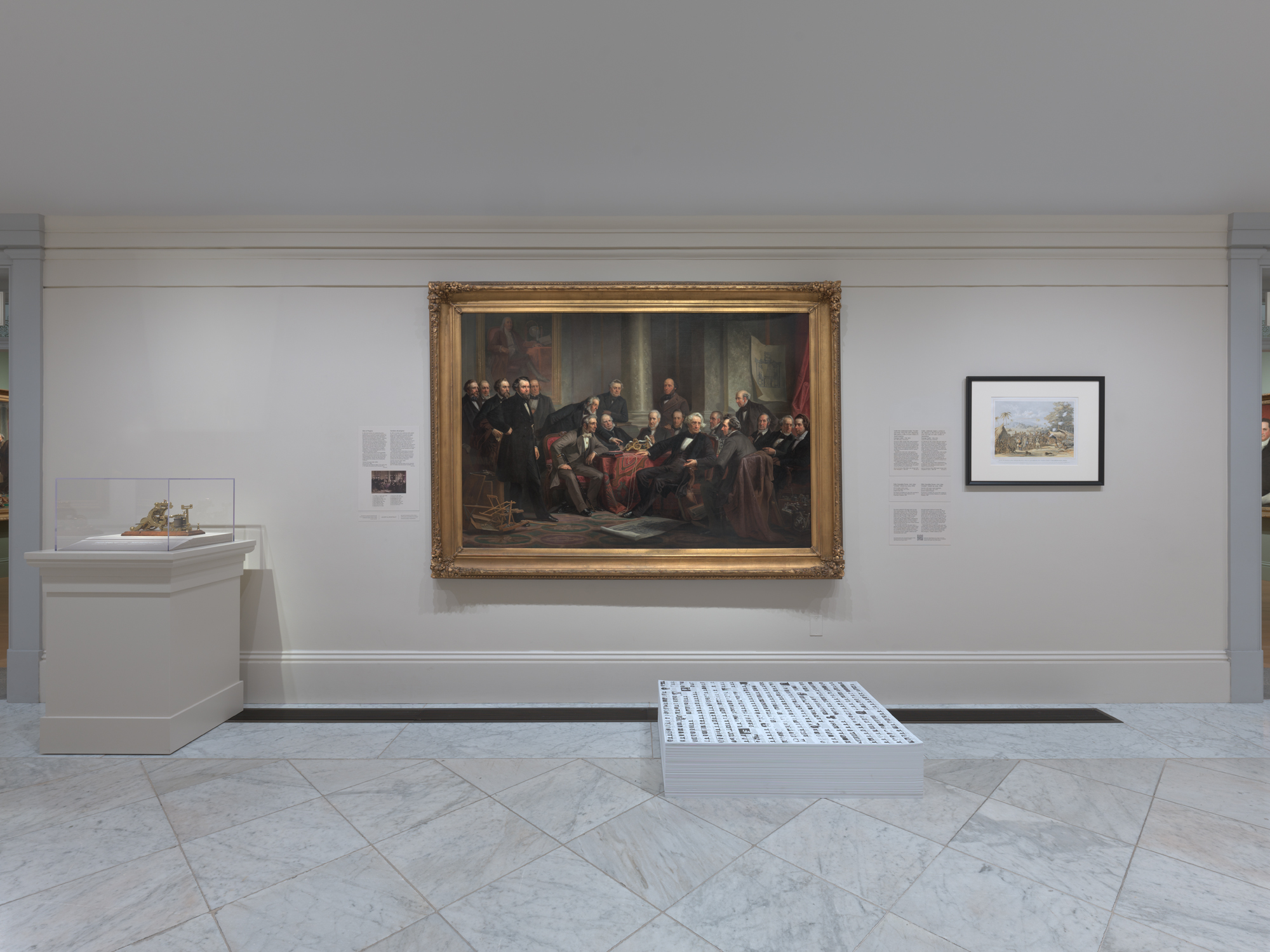
“Untitled” (Death by Gun) (1990), Printon paper, endless copies, 9 inches at ideal height x 45 x 33 inches (original paper size)
© Estate Felix Gonzalez-Torres (Courtesy Felix Gonzalez-Torres Foundation, Photo by Mark Gulezian/National Portrait Gallery)
Gonzalez-Torres’s art also reaches into the present, which is most evident in his exhibited word portraits. These portraits, composed of formative events listed in silver paint around the perimeter of a room, were made with the input of their initial owners to create a timeline of personal and public moments that represented them. New versions of a portrait can be created with the owner’s permission, and in this exhibition, events such as “CDC 1981” are joined with “PrEP 2012” and “CDC 2020,” which occurred after the artist’s untimely death from AIDS-related complications on January 9, 1996. Other posthumous events include “January 6 2021” and “Equestrian Statue of Theodore Roosevelt 2022.” In this way, Gonzalez-Torres’s work, and particularly his conceptual portraits, represent not only specific people, times, or places, but also the broader contexts that surround their beholders and the institutions in which they are exhibited.
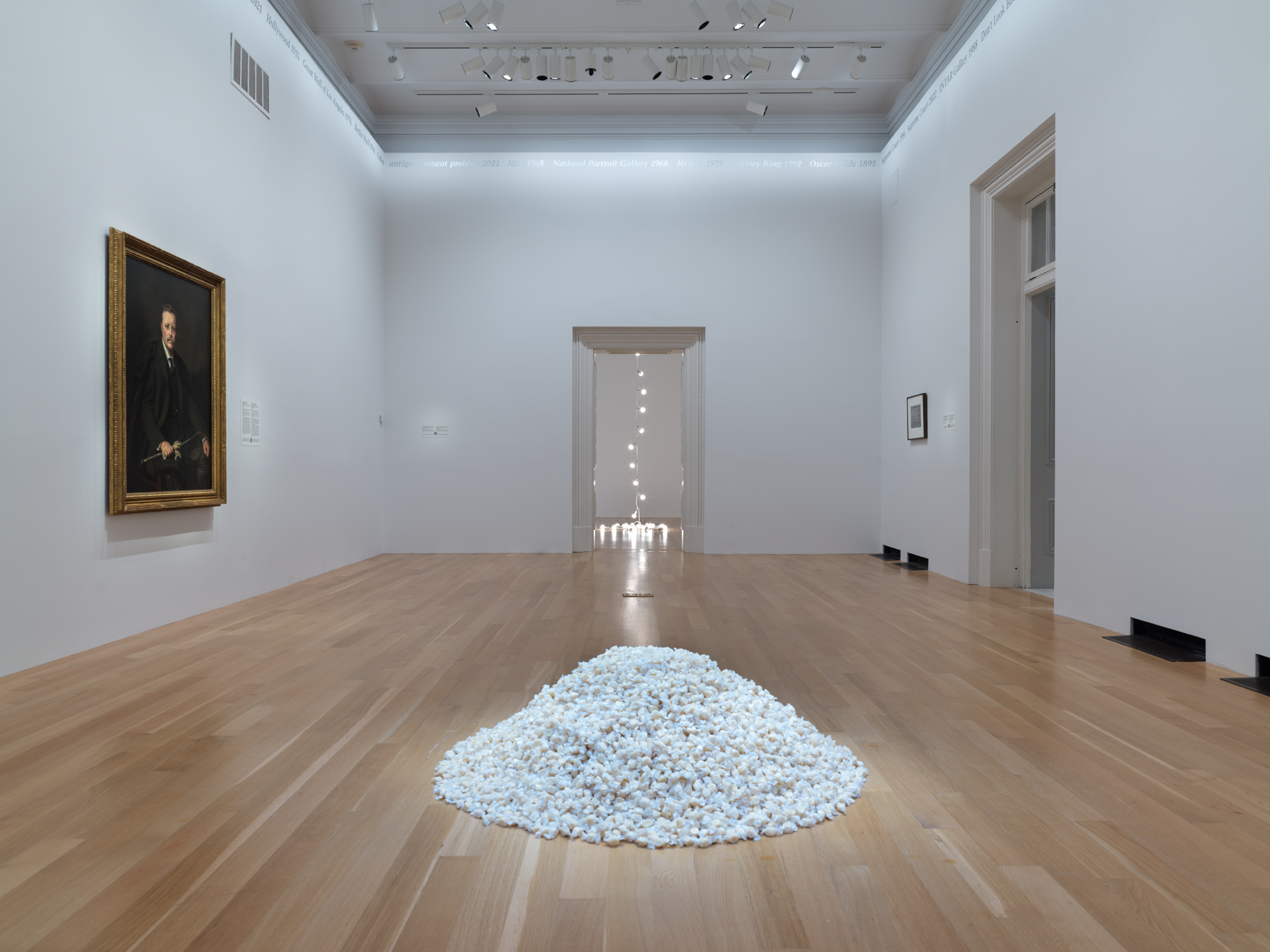
“Untitled” (Portrait of Dad) (1991), White mint candies in clear wrappers, endless supply, Overall dimensions vary with installation, Ideal weight: 175 lb.
© Estate Felix Gonzalez-Torres (Courtesy Felix Gonzalez-Torres Foundation, Photo by Mark Gulezian/National Portrait Gallery)
When I visited Felix Gonzalez-Torres: Always to Return, I was struck by the juxtaposition between the interpretive openness of Gonzalez-Torres’s work and the specificity of the National Portrait Gallery’s mission to “tell the story of America” through portrayals of the nation’s people. How did you formulate the ideas behind the exhibition?
I saw Felix’s word portraits at Andrea Rosen Gallery in 2016, in an exhibition curated by Julie Ault and Roni Horn. They blew me away with their complexity, as they told history differently through portraiture, and I wondered how that process could be modeled in an exhibition.
Felix’s work is exhibited all around the world, so I knew that place and context would be critical in order to bring something additional to the work. We got very specific about site: our site as a collection, our site at the Smithsonian, and our site in Washington, D.C. This involved placing art from the collection in conversation with Felix’s work, and then moving the exhibition out into our city.
When I started at the Portrait Gallery and learned that the Archives of American Art was home to the Andrea Rosen Gallery records, I approached Josh Franco about a potential collaboration between us and our two units, as we call them in the Smithsonian. I like collaborating, and more than that, I was trying to create a discursive conversational format that would make the sum greater than its parts.
Collaboration pervaded my experience curating the show and writing new versions of his word portraits. This approach complemented the doubling, twoness, and coupling that are present throughout Felix’s work. With the Archives’ footprint in the museum building, we had the opportunity to move beyond one single space, which highlighted the multifaceted nature of his portrait practice. Between his artwork and his correspondence, we see the logic of lists, the major and the minor, and other themes echoed across different materials. The Archives offered a great space to do that work.
I was originally thinking about a survey of his portrait works, but we moved away from that format through conversation and deeper thinking. That’s something I’ve learned from Felix: his work is about being open and humble enough to know that you might start with one idea, but you also have to learn and let your thinking change. This is now how I want to approach everything I do.
There are moments when the exhibition refers to the history of the institution, and I noticed that, in some ways, the galleries form a portrait of the National Portrait Gallery itself. Did you and Josh see your work in this light? In what other ways did the venue inform the exhibition?
As a curator, I think one of my responsibilities is to create a conversation between the context in which the work was made and the context in which it is exhibited now. Greg Allen articulated this so beautifully in a recent blog post about the show. It just so happens that, within this exhibition, some of that conversation includes the history of the building and the institution.
I hadn’t originally thought of the exhibition as a portrait of the institution until I was asked. I think that it could be. Felix made word portraits of institutions, which prompt a key question: who gets to represent the institution? A really beautiful takeaway from the institutional portraits—like “Untitled” (Portrait of MOCA), which we have on view—is that an institution is ultimately made of people. It’s a portrait of MOCA, but there always has to be a person to make the versions of the word portrait, or interact with lenders, and so on. That tension is really interesting to me. An institution is a mission statement, it’s a building, it’s a set of systems, but it’s also made of people, and it’s not static. That informed our decision to write and sign two different introductory statements to the exhibition. We wanted to destabilize the idea of an authoritative institutional voice. While the exhibition relates to the institution, it’s also a model of how we tell history, which I see Felix working through in these portraits.
I did fear that that displaying figural works from the Portrait Gallery collection alongside Felix’s pieces, speaking directly to some of his parenthetical titles, could close down the potential meanings of his work. I hope that this approach presented the art in unexpected and meaningful ways. In doing so, I could see his work with fresh eyes. Through that process of thinking about these connections, I strove to model the kind of history-writing that he proposes with his art.
What was the process of contributing to the word portraits? Did you think of these interventions as expanding a portrait of the subject, or of creating a portrait of you and Josh, or as something else?
When you borrow a word portrait, you don’t automatically have permission to create new versions, but we were granted that right with all three of the word portraits in the exhibition. The process for each portrait was different, and frankly, I didn’t know what to expect going into it.
Robert Vifian, the subject of one of the exhibited portraits, is amazing. I’m so thankful that Felix’s work allowed me to be introduced to him. Robert collected other works by Felix and commissioned this word portrait; he is a really visionary collector. He happens to be both the owner and the subject of this piece, and it was great to co-write this version with him.
This is the first time that his portrait has been shown in the U.S., and we took a pretty light touch with it. He told us which version he wanted to use, and most of what we added spoke to the context of the room in the exhibition. Then, as a result of our conversations, Robert added a few new events and dates. Josh had the opportunity to go out to Paris and saw a version of the word portrait installed in Robert’s home, ate at his restaurant, and went to visit the Gertrude Stein & Alice B. Toklas grave, which was the subject of two of Felix’s other works in the exhibition. It was Josh’s first time in Paris, and it was all kind of framed by Felix.
Bringing “Untitled” (Portrait of MOCA) to the East Coast, to a very different kind of institution, came with a very different kind of site specificity. When displayed in the Smithsonian, “MOCA” is not necessarily recognizable, as it’s not even spelled out in the title. It required a real balance between being a portrait of MOCA or the Portrait Gallery, and our thoughts of MOCA and L.A.
I would say that “Untitled” was the hardest one. I still think about it—and have my regrets! This was Felix’s first word portrait. When it was first shown at the Brooklyn Museum for VisualAIDS’s inaugural Day Without Art in 1989, it only consisted of seven events and dates. But now there are more than forty versions. It also grew during his lifetime. We wrote two versions of “Untitled” for the exhibition. One version is installed in the main corridor of the exhibition, and a different, shorter version is in the Archives of American Art gallery in the same building.
We couldn’t help but think about the fact that, at one point in time, Felix called it “Untitled” (Self-Portrait) for his show at the Hirshhorn in 1994. He ultimately landed on “Untitled.” It’s the only word portrait without a subject named in parentheses. That makes it hard: it’s totally expansive. At the same time, I couldn’t get out of my own head knowing that a lot of the work’s reception centered on the former title, “Untitled” (Self-Portrait). However, these interpretations are not mutually exclusive: biography is there, and so are other things. They inform each other.
The word portraits are supposed to include events and dates that were formative for the subject. But this one doesn’t name a subject: could the subject be us, our personal lives, our professional lives? Does that distinction even matter? It’s a really difficult process and a huge responsibility. There is a generosity to it, sure, but Felix makes you work hard, and in ways that you aren’t trained to work.
To begin drafting new versions of “Untitled” for the exhibition, we reserved the Archives of American Art conference room and covered long tables with butcher paper. We read aloud all of the past versions of the word portrait, wrote them down, and started moving things around and talking it out. You begin to notice patterns and repetitions across portraits. It’s an overwhelming amount of information. I asked an intern to research almost every single term. Of course, sometimes we just didn’t know what a term meant, and each one could have multiple possible meanings. We tinkered on our computers for months at a time, had another retreat, printed out the text to scale and arranged it around the rooms, and we only stopped when we had to get a quote from the sign painter. We also had to make decisions during the installation. For example, all three portraits call for metallic silver paint, but we had to decide what that meant. The Archives space is painted blue, so it was harder to read the paint color that we used upstairs on white walls. With our permission, Sean Danaher, the sign painter, added a little pewter to make it more legible.
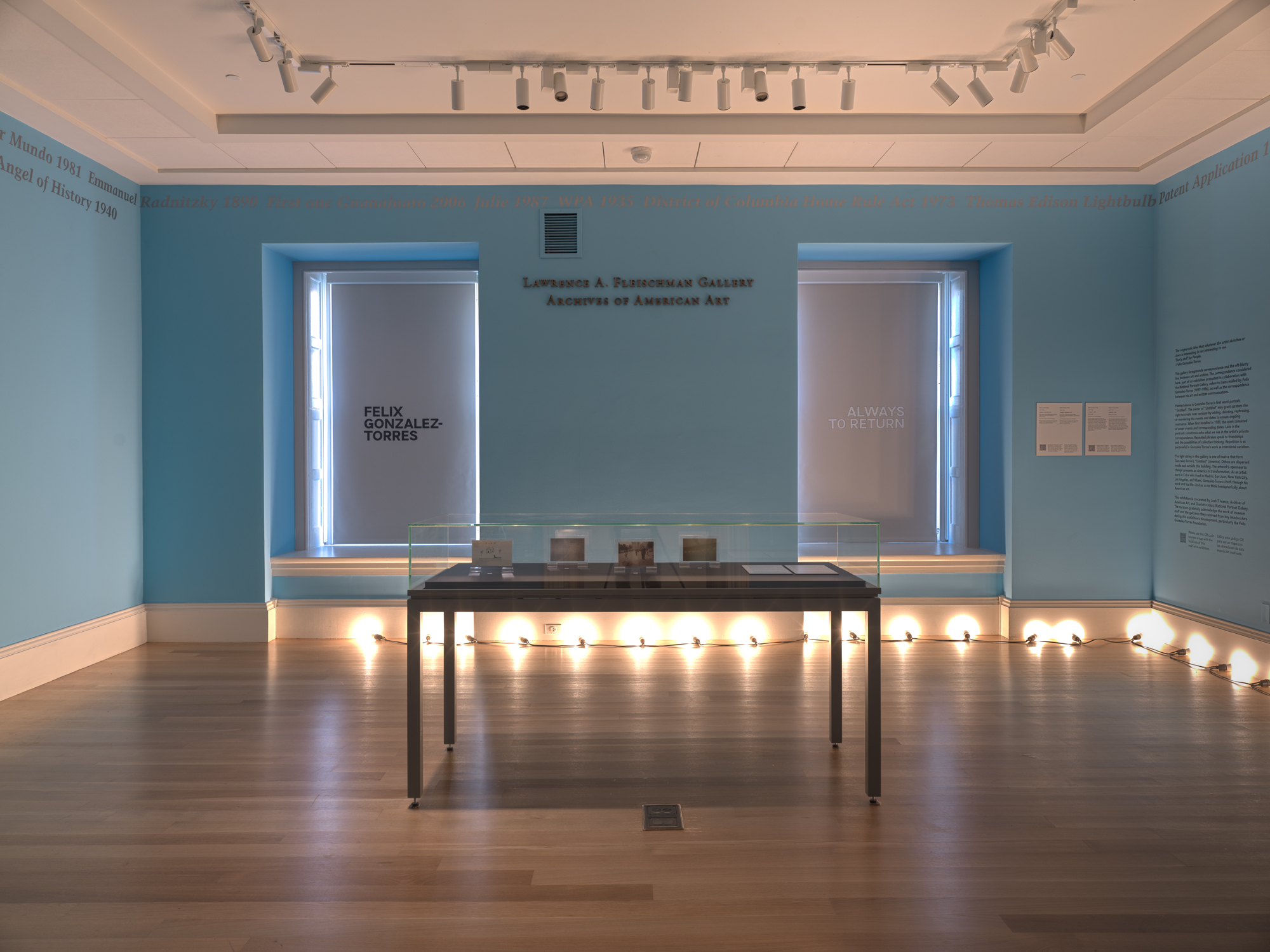
Installation view of Felix Gonzalez-Torres: Always to Return
(Photo by Mark Gulezian/National Portrait Gallery)
I imagine all of these materials from the retreats are kept somewhere?
I think it’s all in Josh’s office. The paper has food stains on it from lunch and snacks; we were in that conference room all day. That’s the thing about this work—you can’t just put something on view and write a wall label.
The work really brings people together; I love picturing Josh in Paris with Robert.
The world Felix built was so amazing. Some of the people we’ve met… I treasure those conversations. In terms of this exhibition, I’m very cognizant that we curators come from a generation that is several generations removed from Felix’s life. Many of the great shows were done while he was alive, with people who knew him, or who had lived experience of his generation. I’m very aware of our distance, and I’m not saying that one is better than the other. It just is.
Did the nature of the art or of the exhibition create opportunities to work in new ways, either for you as a curator or for your colleagues? I’m struck by the amount of physical work involved: clearing debris from the candy piles, straightening up the paper stacks, and so on.
The caretaking is significant. Josh and I have done a lot of hands-on work, including during the installation. The maintenance of the show is a huge amount of effort—it’s way more than I expected and has been a real learning experience. We’ve done at least five roll calls with our security colleagues and are in continuous conversation. The work also entails care and tending in physical ways: replenishing piles and stacks, tidying things up. I’m always removing the scuff marks from “Untitled” (Death by Gun).
It’s so complex. This is only the tip of the iceberg, but I know that my experience with Felix’s work and keeping it on view will forever change the way that I approach my curatorial work. His art will always be with me in that way, long after the show closes.
Could you return to the title of the exhibition, and take us through how you chose it?
The title is from the video “Untitled” (A Portrait), which for me, is one of the most significant works in the exhibition. At one point, we thought of using “Angel of History” as the subtitle, from Walter Benjamin’s Theses on the Philosophy of History, which is important to our thinking, and Felix was a great reader of Benjamin. We have “Angel of History 1940” in the version of “Untitled” exhibited in the Archives space. We ended up choosing the title “Always to Return,” and the piece that it comes from still feels so resonant now, decades after it was made. It’s both of its time and of our time. The work says things like, “a new Supreme Court ruling,” or “a distant war.” It also includes “a shortness of breath,” and we worked on this during Covid. These histories are a series of returns.
I was also thinking about “returns” while you described maintaining the work. The art may be generous, but it also demands a lot of its caretakers; it requires that you physically return to the work in order to care for it.
Yeah, that’s funny—it’s also a physical return. In the most basic way, it underscores the root of our profession, cura, curating as a form of care.
Another way to think about returns involves the ways in which many of us keep returning to Felix’s work. I think it’s because of that beautiful tension in the art, which prompts us to think through the moment in which it was made and the world in which it is exhibited now. It underscores this idea that the past always returns to shape our present.
It’s interesting that people still refer to him by his first name, even those that didn’t know him personally.
Yes, it’s a phenomenon that Glenn Ligon and Joshua Chambers-Letson have written about. There’s also “FGT.” I can’t think of another artist like that. There’s something in the work.
We half-joke that Felix is the third curator, because his work is not only the subject of the show—it’s also the structure of the show.
—
Claire Dillon is the 2025 Paul Mellon Rome Prize Fellow in Medieval Studies at the American Academy in Rome and a PhD candidate in the Department of Art History & Archaeology at Columbia University. She has a background in the history of conceptual art, while her current research explores the intersections of visual cultures, identities, and faiths in the medieval Mediterranean and their modern afterlives. With this experience, she continues to write on diverse subjects across time, place, and media. You can read about her work in Rome here.
Claire would also like to thank Josh T Franco for meeting her in the galleries and for his contributions to this conversation.
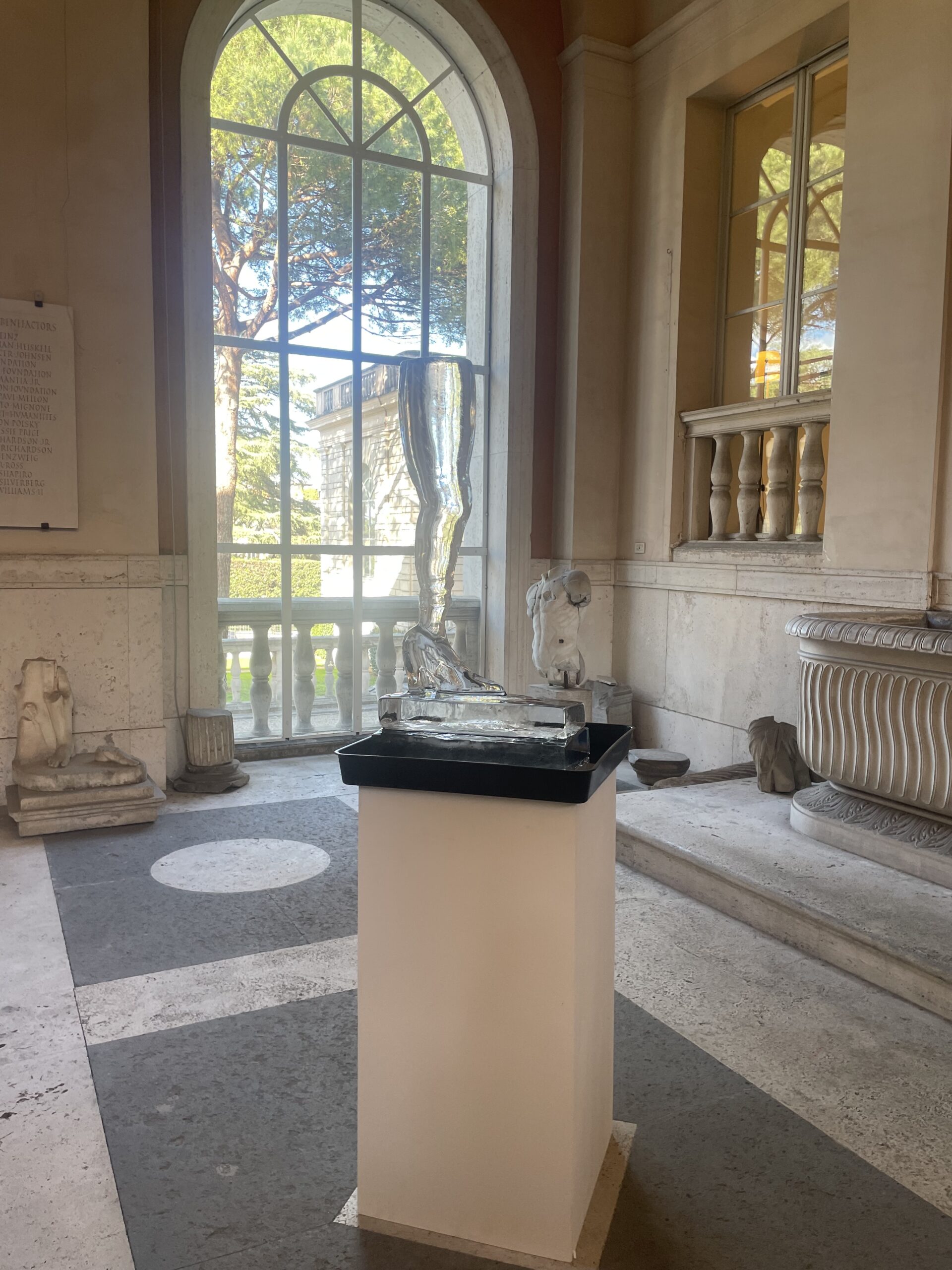
Lizzi Bougatsos, Self Portrait, at the American Academy in Rome
On March 31st, Devon Dikeou brought Lizzi Bougatsos’ Self Portrait to the American Academy in Rome, as part of a presentation with art historian Julia Rose Katz, after they realized that they both shared a connection to Bougatsos – Dikeou as the largest collector or her artwork, and Katz whose work is influenced by her personal experiences that evoke themes of breakage and repair as well as the use of found objects, also characteristic of Bougatsos’ work. Self Portrait, a mold of the artist’s leg in ice, posed a playful (and temporary) addition to the collection of fragments from Roman statues in the lobby of the Academy.
In an art market where money is the medium, Bougatsos’ sensibilities remain refreshingly punk. In an interview with zing she once explained that she considered art to be, “basically a gluttonous production of waste and more garbage and more things that we’re going to have to bury,” when asked why she’d turned to working with ephemera like garbage, living plants, and of course–ice.
Because of her concerns with medium, Bougatsos’ work often feels like it’s mid-process, like a force of nature, something that is always becoming something else. She refers to this ecstatic dance of creation and destruction, writing in a contributor’s statement for zing #24, as if a priestess invoking primal forces:
Aloe dripping from their tongues as they chant the sounds of God, ancestors, jungle flora, and spit. Money is flying. No one gives a shit but they want it all and the rum on the top of the pole, greased with lard.
The project for which this statement was written, Looking for M.J., presents a kind of visual poem that operates on an instinctive logic rather than an intellectual one. Right away, reality is suspicious. The title, which alludes to the conspiracy theory that Michael Jackson faked his death (as Elvis and JFK before him), is paired with an image of a man in a Bigfoot-like mask. Later, a blurry image of a woman awkwardly wrapped in a blanket channels Warhol’s Suicide (Fallen Body). There’s a sense of the mythical, but also a sense of the absurd.
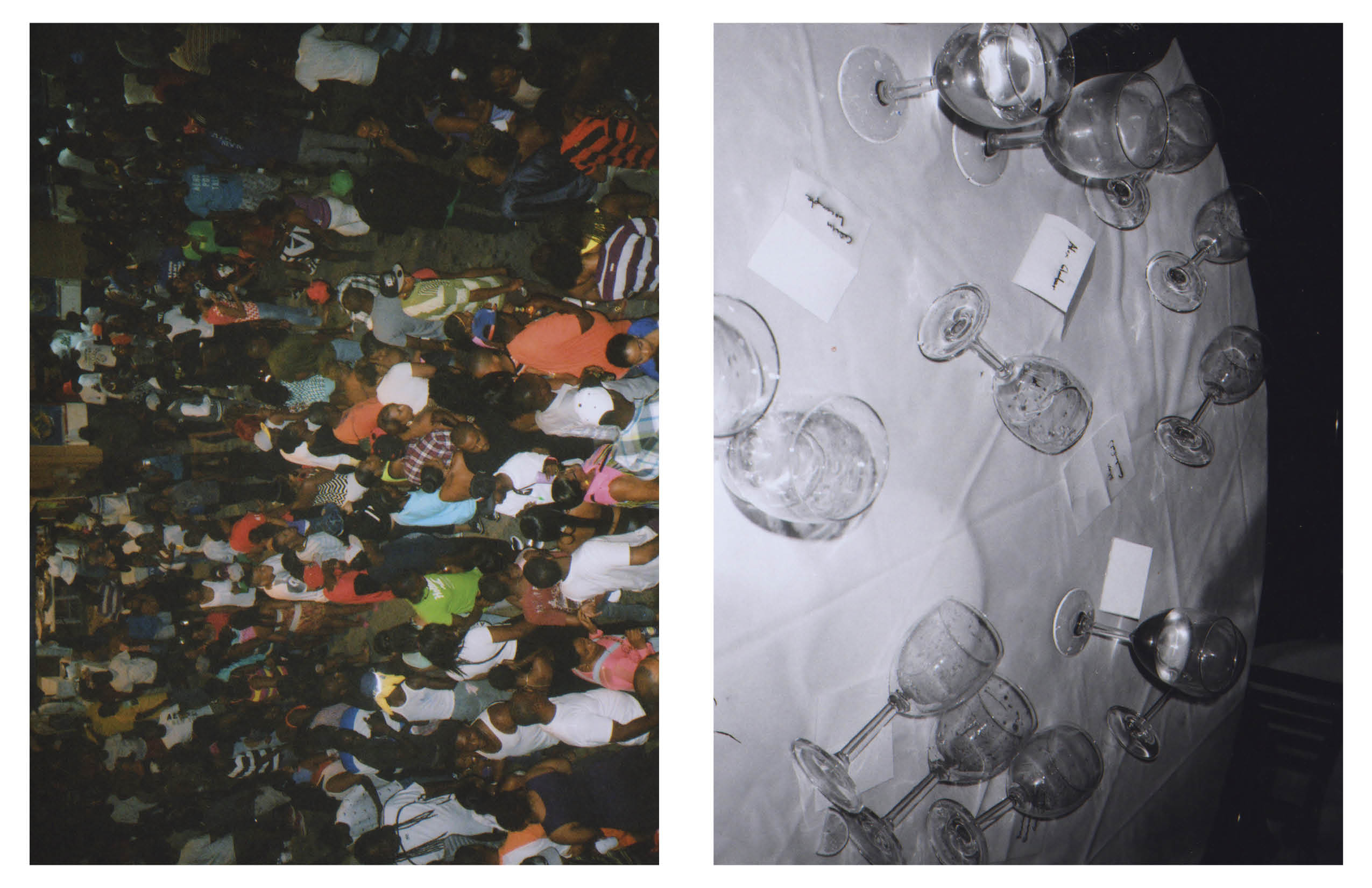
two-page spread from Looking for M.J., zing #24
Across 14 pages, images continuously talk to each other in a way that is only partially comprehensible: a photo of a dance party across a table of toppled wine glasses; a few pages on, a single wine glass casts its ghostly outline onto a wall—across from a gnarled, split tree root, which resurfaces in the background of an image of a Virgin and Savior headstone in a cemetery, thematically echoing the ghostly outline of the glass.
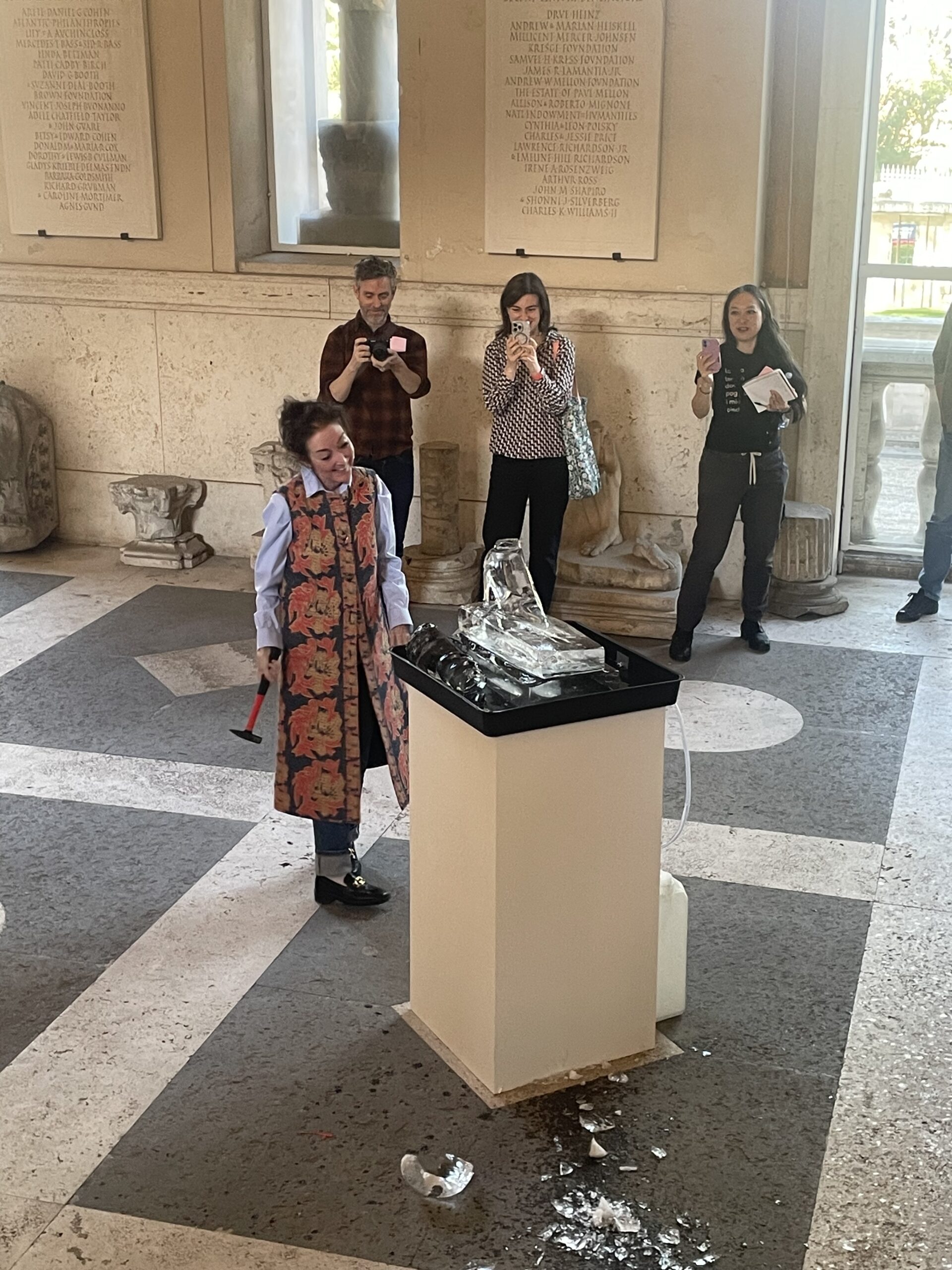
Devon Dikeou showing how it’s done at the American Academy in Rome
There’s something about the vibrant and gritty energy of Bougatsos’ work that feels like you’re at a house party at the end of the world – ancient statues reduced mostly to kind-of-cool rocks, mourning dressed up as nightlife. Ice melts and mountains crumble. All civilizations end up as ruins. It’s strangely comforting in 2025 in a world that feels like it’s perpetually collapsing to go on anyway, dancing on the edge, waiting for the bass drop.
-Rachel Dalamangas
Correction: An earlier version of this post mistakenly referred to Katz as Rose Katz. Additionally, language was adjusted to better describe her relationship to Bougatsos’ work.
Lessons of New York is an unfinished collection of oral histories from the LES art scene of the 70s and 80s
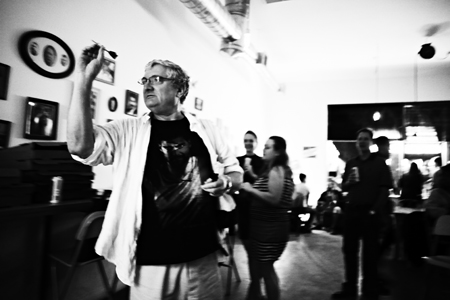
Walter at zing #22 release party in Miami, December 2011
I first met Walter in 2013 when I interviewed him at his LIC studio for zing, shortly after moving from Denver to NYC. I was a walking cliché of a cliché – a young writer in New York.
After the interview, Walter asked what I was doing in the city, and when I told him, he said, “Well, I don’t see you becoming the next Susan Sontag,” then invited me to wander over to some LIC exhibit openings with him.
When I began collecting stories about the LES in the ’70s and ’80s—a sprawling, unfinished oral history for which I interviewed Walter again in 2015—he was incredibly supportive.
“I’m far too lazy for a project like this,” he said.
And, “I’m too shy to call all these people up,” he said, quick to pull out his phone to share contacts for subjects I wanted to interview.
When I occasionally ran into Walter at exhibit openings, he’d give me a cranky pep talk that vaguely had the tenor of a coach trying to motivate a lazy athlete.
“You gotta dig, really dig, ” he said.
“Are you still doing that thing? Keep going,” he said.
I didn’t keep going after about 2016.
I stopped writing about art, and saved the many hours of audio files I’d collected to a hard disk drive that went into a box of files I didn’t know what to do with, where it would remain for nearly a decade of life’s great ups and downs.
American poet Gertrude Stein said, “We’re always the same age inside” – awkward wisdom on mortality that makes me think of this story of Walter – the kid inside the ‘old man’ – newly arrived in New York, catching glimpses of the city through his eyes, looking past the ‘hill’ of Columbia, imagining what awaited him downtown.
Interview and editing by Rachel Dalamangas
WALTER ROBINSON:
You know there’s this notion that we know what we’re doing and we’re in control of our lives, but actually of course we’re not. We don’t know what we’re doing and we’re not in control of our lives. And how I ended up in New York I would say is just an accident. But there must have been something, some psychological thing.
Here I was in Oklahoma. Eldest son of a completely middle-class family. Typical angry, repressive, hard-working father.
And I could have stayed in Oklahoma and lived in Oklahoma and been bored, but somehow, I felt enough out of place unconsciously that I came to New York.
I came to New York in 1968. It’s not the typical story when people come to New York. Most people, you know, they pack their bags, and everything, you know? For me, eh, I just came for college and never left.
I was afraid of the city. You’re cloistered on the hill at Columbia at school and they would tell us, “Don’t go downtown. You’ll get mugged.”
I was really slow on the uptake. I discovered the art world when I was in college and started going to museums and started to go to galleries in SoHo and got caught up in the art business that way.
Where the Twin Towers stood it used to be nothing. It used to be a landfill. There was nothing there. It was like a beach. They’d do performance art there. Martha Wilson would curate it. I saw Sun Ra there.
When I got out of college and moved downtown, my rent was $220, and I think I had a job typesetting. Somehow I got into the typesetting business. Maybe it was freelance for Sing Out magazine. Or maybe it was part-time for this newspaper called The Jewish Beat. I made $6/hour, and I had more money than I knew what to do with.
By the end of the 70s in SoHo, there was this SoHo style painting. Painting that didn’t know what it was doing. Say the dean of SoHo painters was Ron Gorchov. That kind of abstraction. Judy Pfaff for instance is another. People who are still carrying on in abstraction even though it’s been bypassed by newer aesthetic developments.
In the early 80s, I moved to Ludlow Street, and I was hanging out with all my friends from Colab. I had a job. I worked at Art in America, and I guess I was looking for another extracurricular activity. I had been president of Colab and decided to quit I think in 1982.
I had my own painting by then. Now if I had been smart, I would have pursued painting 100%. That’s what I recommend to young people. Don’t get a job. Pursue your art 100%.
I was looking around for another project and somehow, I got the job of being the art editor of the East Village Eye. I guess Leonard asked me if I wanted to do it, and I said yes.
Carlo McCormick was already writing for them and that’s when I met Carlo. He was already writing about the piers. There were a lot of artists that would go over to the piers and insert artworks. I never even went over there. There’s this famous David Wojnarowicz painting of like a giant cow’s head with a tongue sticking out painted on a wall at the piers. They’re all marked out by now of course.
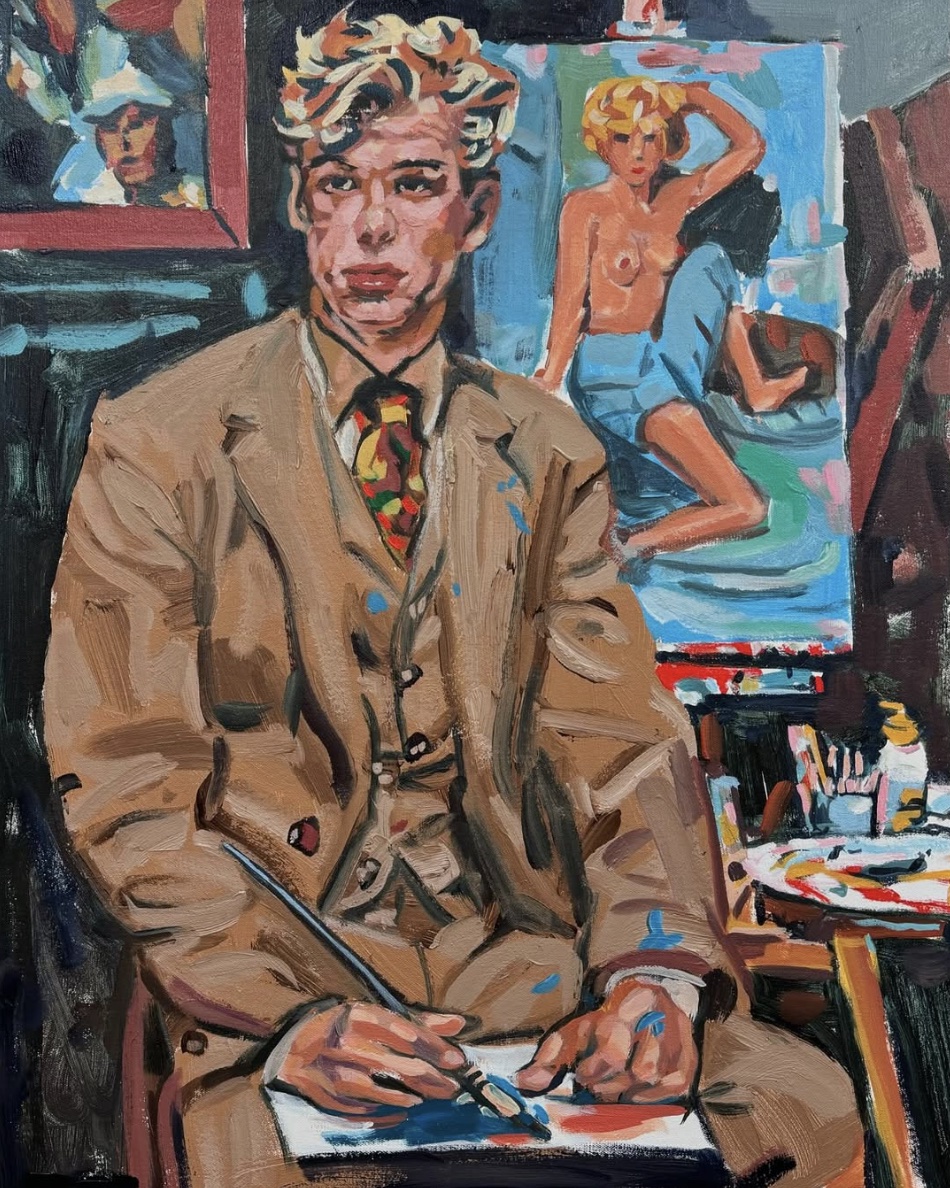
Self-Portrait (after Matisse), 2024
At the East Village Eye, we had a lot of fun writing nonsense.
I wrote a little review of a guy’s show just by looking in the window. I didn’t go in and look at the art and he got mad at me about that.
I had the whole Waltergate thing. You may know about Waltergate. When I stitched together a bunch of press releases and ran it as a column as if somebody had written it. The funny thing was that poor Barbara Gladstone complained and then the art critic Joe Matsheck who was a player in those days wrote in to support me. Judd Tully complained because he’d been misquoted. It was funny because Judd blamed Carlo because Carlo had written the column next to it. It’s all very confusing.
That whole [1983] Whitney Biennial was harshly criticized as being the “East Village Biennial.”
That’s when it became clear to me the scapegoat that the East Village was becoming for all things that people thought was bad about art. “The New Art’s too stupid or too gaudy or somehow meretricious.” “The East Village is only about money.”
Conservative forces, whether it’s Robert Hewes or writers for October magazine would attack the East Village and attack the Biennial as the East Village Biennial even though in fact there were only a few artists associated with the East Village in it. Most of the artists from the East Village have never been recognized by the museum structure.
The East Village represented these upstarts, these upstarts who are bad.
But you can’t say the same thing was true about Keith and Kenny and Jean-Michel. They were the triumvirate.
Keith was a star before anybody even knew who he was because he was doing his Radiant Child barking dog graffities all over on plywood in construction sites and on the subway and people really liked those. Even though there was a big graffiti movement, his stuff is really not that vandalistic. Like a lot of the graffiti writers would write all over the trains. So he was already very popular with the people.
And then when Jean-Michel had his first show, there was this intense buzz. Everybody loved that. Really came out with his first show at Anina Nosei in SoHo. Tremendous buzz about it. That was the show where he was supposedly locked in the basement and kept painting. Everybody just loved that stuff.
So Kenny’s adaptation of a Hanna Barbera look fit totally in with whatever it was that was happening this 80s – the American 80s painting revival.
It’s also part of the Tony Shrafrazi aesthetic.
Tony had a bunch of other artists that are kind of forgotten now. Like Brett De Palma, Ronnie Cutrone. I think what happened to Ronnie was that he wasn’t focused enough on the art business because he was too much of a drug addict. The art world can be harsh on people who are drug addicts, people who get a reputation for being junkies.
There’s nobody like Tony. He’s a little bit insane now, I think. He’s really enthusiastic about art. He’s very meticulous. That’s why he loves Jeff Koons so much. Because they share almost obsessive-compulsive meticulousness. Tony’s the kind of guy who has to have an assistant to wait around for him because he doesn’t really know how to lock up.
In the art business, you want to be known as the go-to person for something. The art world is full of go-to people.
You have to have your eyes on the brass ring and you have to go for the brass ring. You can’t be satisfied with sitting in the back of the background.
I was talking to a writer that used to work for me the other day. I had been looking back at my blog on Artnet from 10, 12 years ago. It was kind of like a diary. It seemed kind of like a waste of time, but really it was an investment in the future.
And I was saying to this young writer, “Why don’t you have a blog where you write once a day and post about what you saw or what you’re thinking about.”
But of course, when I was young, if someone said that to me, I would have thought, ‘I can’t do that. I don’t know what I think. I don’t know what to say.’
Now I’m old and I know what I think and I know what I want to say.